
#lakesidepottery
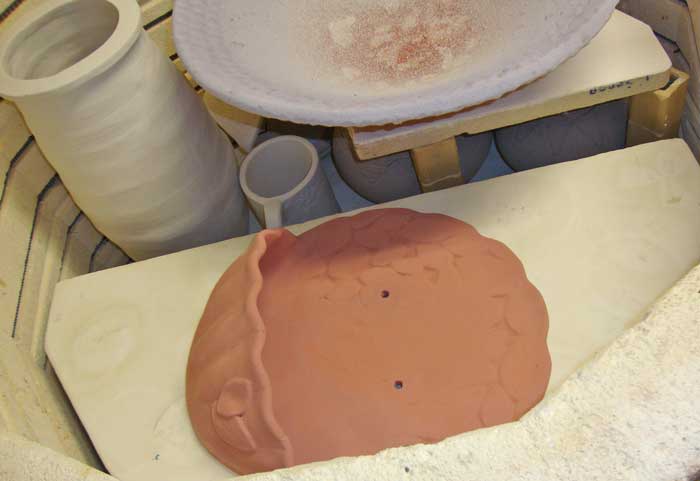
Inside the kiln
|
Selecting the right kiln shelves for your kiln
Choosing the correct kiln shelves for your firing needs is essential for both performance and cost efficiency. The wrong shelves can be unnecessarily expensive, while cutting corners may lead to warping or cracking after only a few firings. When selecting shelves, consider three main factors:
- The material the shelves are made from
- Their thickness
- Whether you need full or half shelves.
Your decision should be based on your kiln type and configuration, maximum firing temperature, firing atmosphere (oxidation, reduction, or raku), glazing methods, firing frequency, the weight of your work, and your own ability to handle the shelves safely. Once in use, shelves require ongoing care, including proper kiln washing and occasional reversing to promote even wear.
|
Kiln Shelves Types
1) Cordierite Kiln Shelves *
Cordierite kiln shelves are made from magnesium aluminum silicate, a material valued for its low thermal expansion and low thermal conductivity. These properties allow the shelves to tolerate rapid heating and cooling, making them ideal where thermal shock resistance is important—most commonly in top-loading electric kilns.
However, cordierite shelves are prone to warping at higher temperatures, with a maximum recommended firing temperature of cone 8. For reliable performance, shelves used up to cone 6 should be at least ¾ inch thick, and those fired to cone 10 should be at least 1 inch thick, though the added thickness makes them heavier.
Cordierite’s porosity (13–25%) can cause problems with glaze drips, as molten glaze can penetrate and fuse to the shelf surface. To prevent damage, apply kiln wash regularly. Because of their porosity and limited temperature range, cordierite shelves are not recommended for salt, soda, or wood firings.
Composition note: Cordierite is a naturally occurring mineral composed of roughly 33% alumina, 60% silica, and small amounts of other minerals, typically dry-pressed under high pressure to form kiln shelves.
|
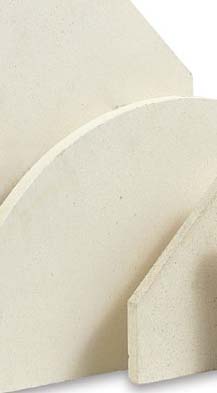
|
|
2) High Alumina Kiln Shelves **
High alumina kiln shelves are similar in composition to cordierite shelves but contain a higher percentage of alumina, which increases their maximum firing temperature rating to cone 11. They can support heavier loads and are less prone to warping, though periodic flipping or rotation is still recommended to prevent sagging over time.
Because they are denser than cordierite, high alumina shelves are more resistant to glaze drips and surface absorption. However, they are not completely non-porous and should still be coated with kiln wash for protection. Like cordierite shelves, they are not suitable for salt, soda, Raku, or wood firings due to their material composition. High alumina shelves perform best in electric or gas kilns.
Composition note: High alumina (aluminum oxide) ceramics are among the strongest and hardest ceramic materials, second only to diamond. They exhibit high dielectric strength, excellent electrical resistance, superior thermal conductivity, and exceptional resistance to chemical and corrosion attack.
|

Heavier kiln load |
|
3) Silicon Carbide Kiln Shelves are thin, lightweight made from an advanced Nitride-bonded Silicon Carbide composition, stronger and weigh half or less compared with a conventional 1” thick Cordierite kiln shelves. They do not sag or warp after many firings under heavy loads and suitable for temperatures up to 2600°F and a great choice for Gas, Soda and firing kilns. They are about twice the cost of Cordierite or High Alumina kiln shelves cost.
|
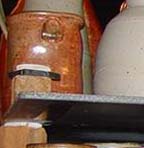
Thinner kiln shelf |
4) Nitride Bonded Silicon Carbide Shelves are thinner with very low mass and high strength substantially reducing thermal mass resulting in reduced energy costs. These shelves will not sag and you may never have to rotate them. ½" thickness will be sufficient to cone 11. Glaze drips and ware will release easily from shelves without the need for kiln wash with the exception of soda firing where an alumina based kiln wash is recommended. Cracks may occur in thin nitride bonded kiln shelves due to heat differences across the shelf caused by heating or cooling too quickly. It is not recommended to use nitride-bonded silicon carbide with electric kilns because they will cause a reduction which may effect the glazes and clay body in an electric kiln. Silicon carbide does conduct electricity and if an element touches the shelf a short or electrical shock risk is high.
|
|
|
Selecting the Right Kiln Shelves
1) Temperature Rating: If firing mid to high temperature (cone 4-10), kiln shelves that are too thin will sag with time so make sure you purchase the right thickness. The shelves thickness options are ½", 5/8", ¾" and 1". The decision need to take into account the firing temperature and kiln shelve length. For example, if your kiln shelf length is 30" and you fire to cone 6, 1" shelves thickness will be a wise choice.
2) Kiln Shelves Size: If you have a large kiln fired to mid/high temperatures requiring a ¾" or 1" shelves thickness, the shelves will be really heavy and difficult to carry in particular in a top loading kiln. Half shelves might be a good choice for the above reason but will also provide you with the flexibility to more efficiently fill every space in the kiln with your ware. Make sure the kiln shelves dimensions allow about 1" clearance between the shelve and kiln's walls for temperatures even distribution.
3) Your kiln atmosphere (reduction or oxidation)
4) Frequency of Firing will expedite shelf sagging if too thin or wrong shelf type selected
5) Ware weight - heavy ware will expedite kiln shelves sagging if too thin or wrong shelf type selected
|

Kiln temperature |
|
Kiln Shelves Storage
Kiln shelves should be stored standing up on their edges. Storing them flat makes it more possible for them to break or cracks. Keep shelve dry. If they do get wet (e.g., after applying kiln wash), heat them slowly and soak for a few hours at 300° F.
|
|
|
Kiln Wash
Kiln wash is a layer of material between your pots and kiln shelves protecting your kiln shelves during glaze firing preventing glazes from sticking to your shelves. Unglazed pots can stick to the kiln shelf if the clay body vitrifies. Kiln wash is made of silica sand, alumina hydrate and kaolin. You can mix your own kiln wash or purchase.
Glaze comes in contact with the kiln shelf when something unexpected occurred (e.g., running glaze, tipped over pot) during the glaze firing even if you wiped glaze off the bottom or used stilts. If kiln wash was not used in the above possible scenarios, your pot will stick to the shelf and break trying to remove it . You will have to grind the glaze off the shelf’s surface, remaining glaze soaked into the shelves will continue to erode the kiln shelf.
We also recommend applying kiln wash to the brick on the bottom of the kiln to prevent from glaze drip damaging the soft brick.
Warning: Stay away from electric kiln elements – kiln wash will corrode and reduce the elements life expectancy.
|
|
|
Applying Kiln Wash
After mixing the kiln wash with water to a consistency of "Half and Half" cream, apply 2 to 3 thin coats with a brush only on one side of the kiln shelf letting it completely dry between each coat. Keep about ½" on the outer part of the kiln shelve kiln wash free of kiln wash to avoid flaking dry kiln wash falling into the pots below later on. Applying kiln wash thicker will causes more peeling and / or cracking.
If you are planning to rotate / flip your shelves over every few firing, you'll need to scrape and grind all the kiln wash from the bottom side first. Failing to do so will cause kiln wash particles to fall into the pots below and ruin the glaze effect.
|
|
|
Grinding Off Kiln Wash Before Rotating Sides
After several firings, the kiln wash will become very thin, uneven or covered with silica from the kiln atmosphere. At that point you should grind off all of the kiln wash off the top side and apply kiln wash to the opposite side. We, at Lakeside Pottery, use the following tools:
|
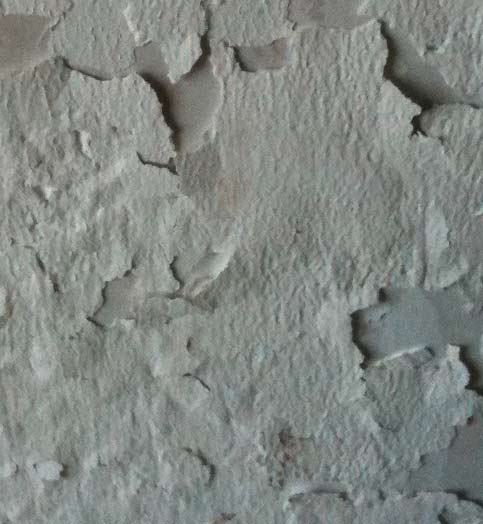
Kiln wash flaking |
|
Rubbing Silicone Carbide Brick with Handle used for small accidents to scrape off glaze drips and remnants of stuck pot's bottoms
|
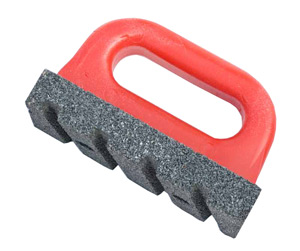 |
|
4-Inch Diamond Turbo Grinding Cup Wheel Coarse Grit used when glaze accidents and removal of kiln wash is required before flipping a kiln shelf.
|
|
|
4-1/2" Makita Angle Grinder – always use eye protection and dust mask or a respirator even if done outdoors.
|
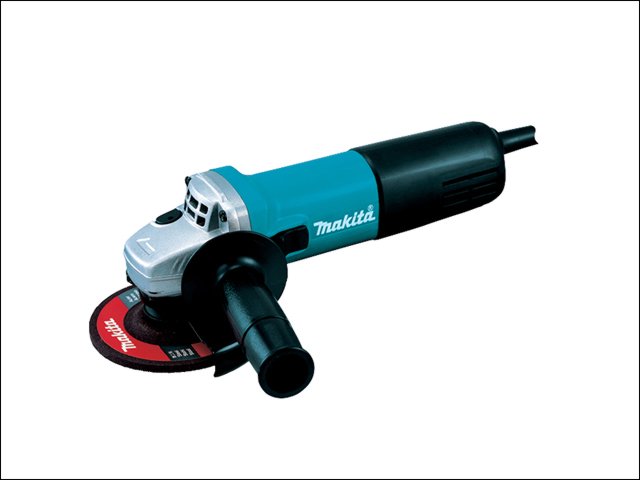 |
|
|